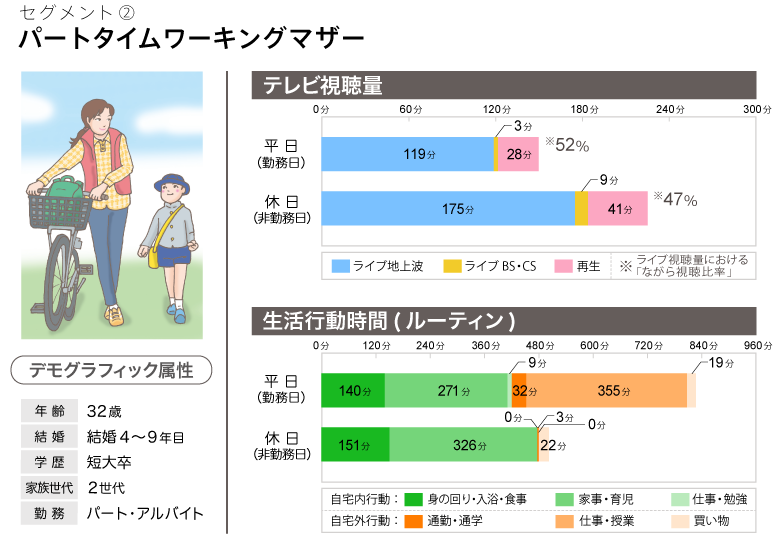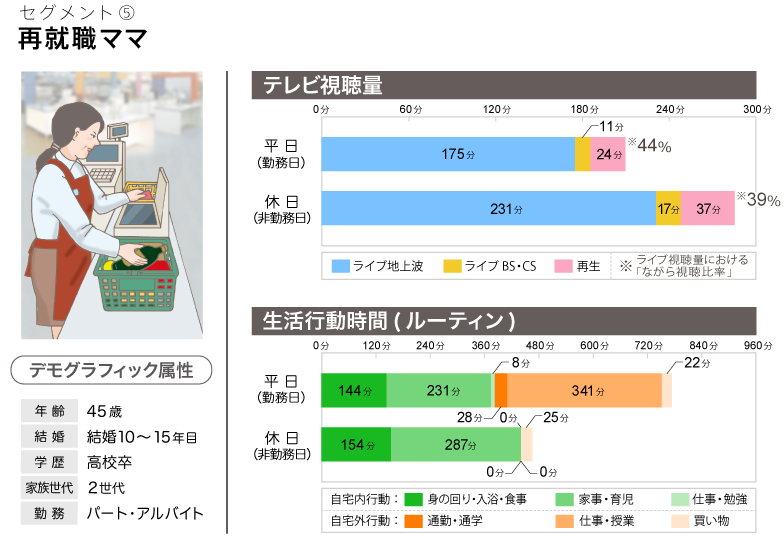Looking back on life, many people probably feel that their relationship with television has changed depending on their life stage. Naturally, preferences for what kind of programs they want to watch evolve, but the amount of time spent watching is also significantly influenced by age and life stage.
Our relationship with television and how we watch it evolves according to our current lifestyle—based on this hypothesis, we delve into the reality of television viewing, focusing particularly on women who experience diverse life stages.
What Factors Influence TV Viewing Time?
Analyzing data from the diary-style survey "MCR/ex" (Video Research Ltd.), which provides detailed insights into daily media activities and various other behaviors, revealed results consistent with the initial intuition. Figure 1 provides an overview of the key findings.

・The "Demographic Attributes" on the far left include age, family living situation, employment status and work type, plus whether the day in question was a work (or school) day or a day off within the week.
・The "Activities at Home/Outside Home" section at the top includes data on commuting (to school), work (or classes), and other routine activities that are likely to constrain TV viewing time.
・The lower section, "TV Attitudes" and "Program Preferences," covers attitudes toward TV viewing and preferred TV program genres. "Daily Life Attitudes" incorporates factor data related to daily life attitudes that could influence these, and calculations are performed accordingly.
If we define "watching TV" as "live terrestrial broadcast viewing time," the influence relationships can be illustrated as follows. Demographic attributes influence daily life awareness and home activities, which in turn affect other factors... and the structure of influence becomes visible, with live terrestrial broadcast viewing time being determined.
What is the overwhelmingly major factor influencing TV viewing volume?
Figure 2 re-illustrates representative scores within this structure.
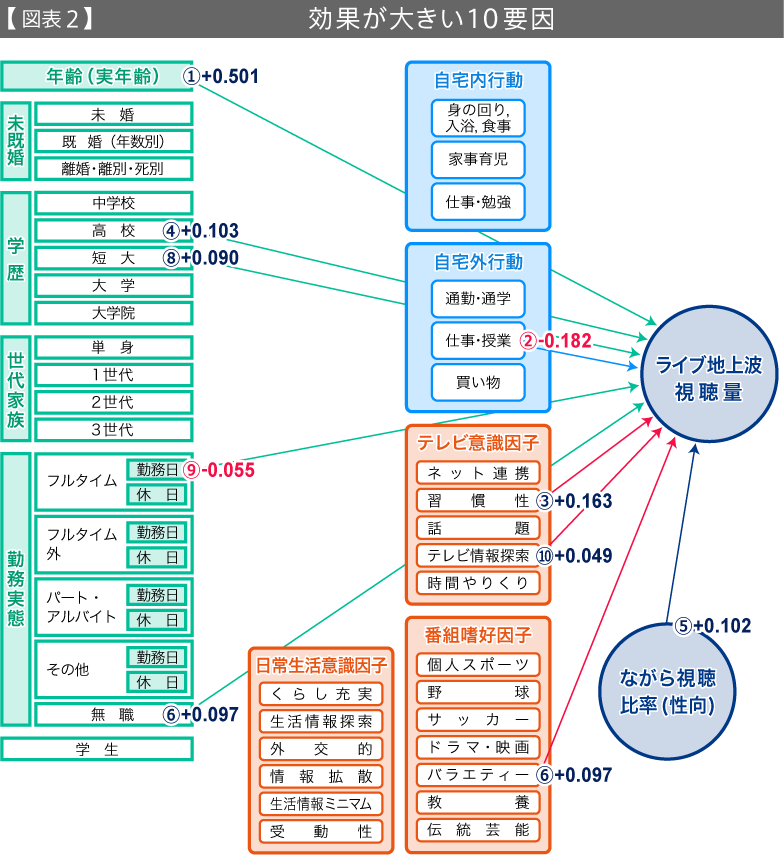
・A positive sign (+) indicates the factor positively influences viewing volume, while a negative sign (-) indicates a negative influence. The absolute value of the number indicates the magnitude of the effect.
・For factors with large overall effects (direct effect + indirect effect), we ranked them and displayed their regression coefficients (displaying separate indirect and direct effects is omitted).
The numbers ① to ⑩ in the chart rank the top 10 factors most significantly influencing women's TV viewing volume. Let's pick out key points from this in bullet form.
Factors influencing live terrestrial TV viewing time
・① Age is by far the most significant determining factor.
・② Longer time spent outside the home for work or school leads to lower TV viewing time, regardless of employment type. Notably, ⑨ full-time workers have lower viewing time on workdays.
・Conversely, viewing time increases with higher levels of habitual viewing (③ Habitual Factors) and multitasking viewing tendencies (⑤ Multitasking Viewing ).
・Regarding program genres, ⑥ a preference for variety shows is key to longer viewing times.
・The effect of final educational attainment is significant regardless of employment status or work arrangement. ④High school graduates and ⑧junior college graduates (or current students) have higher viewing time compared to university/graduate school graduates (or current students).
・Viewing time increases among those who are unemployed, particularly full-time homemakers.
・High scores on TV information exploration factors (⑩), such as "I am well-informed about new TV programs" or "I know what programs are currently trending," correlate with higher live terrestrial broadcast viewing.
This analysis reveals how individual life stages influence TV viewing volume. Examining these life stages further highlights six representative segments among female TV viewers.
Female TV Viewers Divided into Six Segments
Using the "MCR/ex" data introduced so far to quantitatively grasp TV viewing volume and daily activity times, DENTSU SOKEN INC. conducted original group interviews based on the viewer profiles revealed by this data. Combining these qualitative survey results, let's explore the six segments of today's female TV viewers.
As we introduce these six segments, you might recognize someone close to you or even see yourself reflected in them.
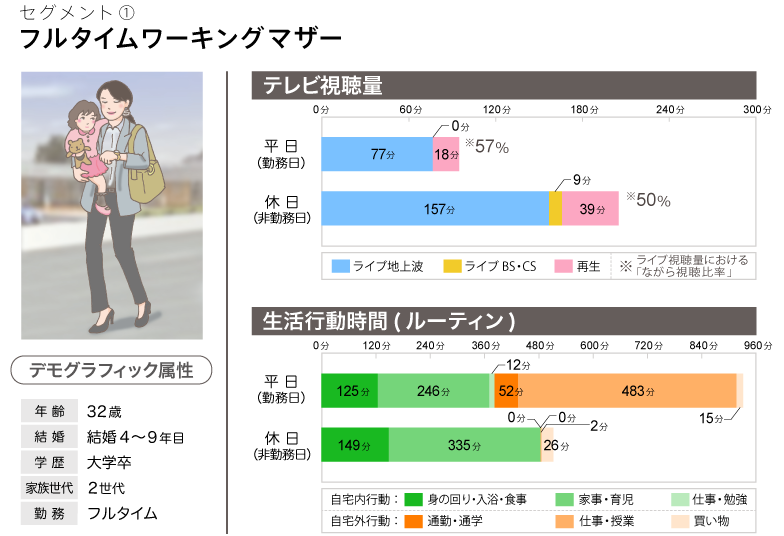
This segment consists of full-time working mothers who continue working after childbirth, juggling both careers and childcare. Their daily activity time is also the longest among the six segments, centered around "work/school."
It's clear they have little time to sit down and watch TV calmly. At the same time, we can point out that among the six segments, they have the highest ratio of "multi-tasking viewing" both on weekdays and weekends.
This segment includes mothers who leave their jobs after childbirth but continue working part-time to support the household. They spend more time at home than full-time working mothers, with weekday TV viewing exceeding 2 hours. Another characteristic is their higher replay viewing volume compared to other segments, both on weekdays and weekends.
After childbirth, they leave their jobs to focus on childcare, enjoying time spent with their children as the center of their childcare-focused lifestyle. On the other hand, they also have a mindset of loving TV so much that they would watch all day if allowed, but currently hold back a little considering the impact on their children.
Busy single women juggling work, hobbies, and socializing with friends. Their TV viewing time is similar to that of full-time working mothers. A key characteristic is that this segment shows the greatest difference in live viewing time between weekdays and weekends (83 minutes on weekdays vs. 173 minutes on weekends, a 90-minute difference).
After their children entered elementary or junior high school and required less constant attention, they resumed work on a reduced-hour schedule. They watch approximately 3 hours of live terrestrial broadcasts on weekdays and about 4 hours on weekends, making them a demographic highly compatible with live programming.
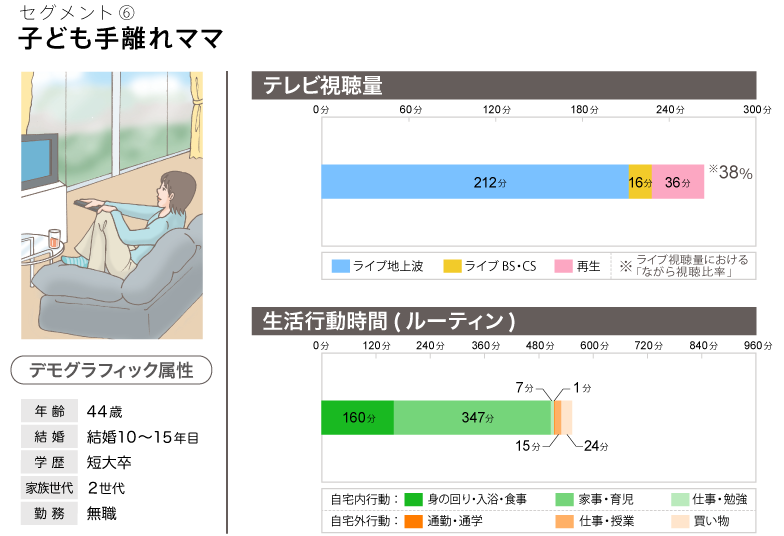
With children entering elementary or junior high school, they tend to spend their free time during the day—when the children are away—doing things like having lunch with friends or watching TV. Live terrestrial broadcast viewing averages about 3.5 hours per day.
Notably, they also have the lowest rate of multitasking viewing among the six segments.
Going forward, capturing female viewers who engage in multitasking while watching TV will be crucial.
As seen so far, the survey reveals that among female TV viewers, viewing time correlates with their life stage.
Generally speaking, the relationship between women's life stages and TV viewing time shows that "later marriage" and "rising employment rates" tend to negatively impact TV viewing time. These two factors are highly likely to continue advancing as broad trends in social structure.
According to the Ministry of Health, Labour and Welfare, the employment rate for women aged 30-34 was 53.7% in 2005 but rose to 71.0% by 2014. Furthermore, the policy direction of a "Society Where Everyone Can Play an Active Role" was announced in 2015, providing another perspective from which to identify these structural trends.
The "multi-tasking viewing" highlighted in this survey can be seen as a phenomenon well-suited to the current era. Furthermore, as women's participation in society continues to advance, the importance of female viewers who engage in "multi-tasking viewing" is likely to increase. In this way, focusing on life stages can also provide marketing insights for considering the future of television viewing behavior.
Furthermore, as mentioned in a roundtable discussion based on a separate survey conducted by DENTSU SOKEN INC. Media Innovation Research Department (see "How Will 'News' and 'Media' Change?" for details), television remains the primary medium relied upon by the 80% of the population outside the highly engaged information segment (approximately 20% of the total).A broad segment of the population still relies on television and word-of-mouth as channels for obtaining and sharing information, even today. This suggests that understanding television's current state and analyzing its audience remains as important as ever.
To grasp television's future, as attempted here, it is essential to secure an analytical perspective that captures not only technological variables like ICT development but also changes on the consumer side, such as the diversification of life stages. Furthermore, as evident from the discussion so far, the findings in this paper also serve as contemporary proof of how television functions as a social apparatus.
[DENTSU SOKEN INC. "Women's Media Contact" Survey Overview]
Data Analysis Survey
● Data Source Used: MCR/ex (Video Research Ltd.)
Analyzed key factors influencing TV viewing time using one week's worth of diary-style lifestyle behavior survey data
Group Interview Survey
●Date: March 21, 2015
●Participants: Women in their 30s residing in Tokyo and three neighboring prefectures
●Number of Groups: 2 groups






